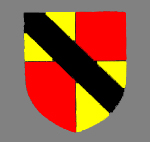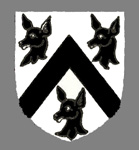Fenlake Barns Manor
A history of the manors of Eastcotts is given in The Victoria County History for Bedfordshire published in 1912. Fenlake Barns Manor was also known variously as Cardington Priors Manor and Regine Manor. It seems to have its origin in Countess Judith’s manor, the second in size of the manors at Harrowden as recorded by the Domesday Book of 1086. Harrowden was the only place in Eastcotts mentioned in the Domesday Book and had three manors. Thus, Fenlake Barns Manor may have extended further than just the settlement of Fenlake to include part of Harrowden.

Barony of Bedford
About 1166 Simon de Beachamp, Baron of Bedford, endowed Newnham Priory in Bedford with three hides of land in Harrowden so clearly the manor had, at some stage, passed to the Barons of Bedford. The manor remained in the ownership of the priory until it was dissolved by King Henry VIII (1509-1547) in 1541.
In 1568 the manor was in the hands of Sir George Gascoigne of Cardington because he mortgaged it in that year to Sir George Speke of Somerset [W57]. He then quitclaimed (i. e. conveyed) the manor to Speke in the following year, presumably because he could not keep up payments on the mortgage [W60].
About 1579 the manor was in the hands of Thomas Colby but in 1599 it was granted granted to Michael and Edward Stanhope, though by 1625 Henry Foster was the owner. The Foster family remained owners until at least 1699 when Charles Foster died leaving his estate to his mother and three sisters. By 1718 the manor was in the hands of John White who conveyed it in that year to Thomas Bedford and Martha, his wife.

The arms of the Whitbread family
In 1779 Rev. Thomas Bedford, to whom the property had descended from his grandfather’s widow, sold the manor to Samuel Whitbread of Cardington for £720. The manor remained in family until the 20th century. A succession of Law of Property Acts in the 1920s extinguished all manorial incidents, courts and copyhold tenure of land. This effectively abolished manors in all but name. The Barns at Fenlake (now a restaurant) does not seem to have acted as the manor house as it was owned by Trinity College, Cambridge, owners of the advowson for Cardington, rather than by the Lords of the Manor.